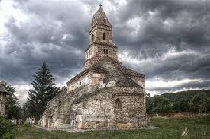The church in Densuş
The village of Densuş is mainly known for to a quaint old church with a hazy history.

Christine Leșcu, 03.09.2016, 14:46
The village of Densuş is located in a region known as the Haţeg Land,
situated in western Romania, close to Ulpia Traiana Sarmisegetuza, the capital
of the former Roman province of Dacia. This small village at the foot of the
mountains is mainly known due to a quaint old church with a hazy history: the
St. Nicholas Orthodox Church, built around 1360. Here is father Florin Dobrei
with the Orthodox Archbishopric of Deva and Hunedoara with more on the origins
of the church in Densuş.
The church was believed to have been a
synagogue of a Jewish community built back in the time of Dacian king
Decebalus, which was taken over by the conquering Roman troops and turned into
a pagan temple first, where human sacrifices were being performed. There is
another hypothesis, namely that the church was built by the Goths, being from
its early days a Christian place of worship. But according to most of the
studies conducted by historians, the church belongs to the large family of
buildings from Moesia around the 12th-4th centuries. All
these historians have also identified the builders, the local voivodes in Densuş,
frequently mentioned in the Hungarian medieval documents, the Mânjina family.
Part of the mystery shrouding the church is related to its role prior to
becoming a Christian place of worship. The church’s appearance has, along the
years, fuelled controversies as to its origin. Built out of white stones with a
high steeple placed on a massive, almost rectangular structure, the edifice is
different from any other place of worship in Romania or anywhere else. The
steeple, maybe the most famous element of the church, is roughly 20 meter high,
being supported by four pillars, each made up of two overlapping Roman altars
of almost three square meters. It was built almost entirely out of stones
coming from altars, tombstones etc, brought from Ulpia Traiana Sarmizegetusa or
from the neighbouring rustic villas. Here is father Florin Dobrei with more on
the pre-Christian period of the church.
In the 18th century, experts claimed the construction was of
Roman origin. The first to formulate such a hypothesis was an Austrian officer
who settled in Transylvania, baron Sylvester von Hochenhausen. In 1775, he
published a book featuring some of the Romanian churches in the Haţeg Land.
This book pays special heed to the building in Densuş. Hochenhausen claims
that, initially, the church was a pagan temple devoted to the Roman God Mars,
erected upon the order of the Roman general Longinus, who was the governor of
Dacia for a temporary period of time, more precisely between the two Dacian-Roman
wars. Starting from this hypothesis, some historians claim that, at the turn of
the 4th century, the old sanctuary became a Christian place of
worship. The current building has a series of elements specific to an old pagan
sanctuary. Some of the elements and decorative pieces are indicative of an
initial pagan character of the building, and I would like to mention the three
funerary lions, two on the upper vault of the apse and one on the tower,
horse-like figures sculpted in the lower part of the column near the entrance
to the naos, as well as on two other columns near the iconostasis, the Latin
inscriptions, copied, reconstructed and translated into German by Hochenhausen,
that mentioned the name of Longinus.
As of the 13th
century, the history of the church in Densuş became easier to understand. Here
is Florin Dobrei again:
At the dawn of the
widely accepted history of the Romanian voievodates or princely states in the
13th-14th centuries, they made the assumption it was a
chapel of the Muşina princely court. Later on, in the 15th century,
it belonged to the Orthodox parish in the region. In the absence of a Slavonic
inscription, experts accept the idea that, between the 16th and 18th
centuries, the chapel was used by both the Orthodox community and the small
Reformed Church community. In the early 18th century, the building
was administered by the Greek-Catholic Church, whereas in the mid 18th
century it appeared in documents as an Orthodox place of worship, following the
census of 1761-1763. It was then returned to the Greek-Catholic church, until
1948, when it became an Orthodox church again.
In recent years, the
church in Densuş has been included in tourist circuits, being an attraction for
many people practicing cultural and religious tourism in the area of Hunedoara
and the Retezat Mountains.





























